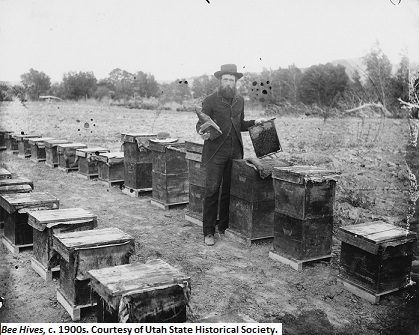Dublin Core
Title
Description
Salt Lake City’s bee inspector is an official position that reminds us of Salt Lake County’s very real agricultural past.
Few people these days know that Salt Lake County has a bee inspector. Hiring someone to watch bees in Utah’s most urban county seems like just another proof of bloated government bureaucracy, but the office—a holdover from the late 1800s when the territorial legislature gave counties the authority to appoint their own bee inspectors—reminds us of Salt Lake County’s very real agricultural past.
The life of a "bee man" in the 1800s could be tough. Inspectors made their living from taxes assessed on each colony of bees in their county. The tax wasn't really high—it couldn't exceed 5 cents per colony—but if the inspector looked at 2,000 colonies, he could make as much as $100 (not a small paycheck for someone living in the 1890s). Henry Taufer, who was named Salt Lake County’s bee inspector in June 1892, worked hard, inspecting at least 4,000 beehives in one year, according to his count. But when he went to collect his pay, the county tax assessor said he'd forgotten to keep track of the number of beehives in the county and could offer Taufer only 50 cents for his salary. The bee inspector was furious at the thought of not getting paid for his hard work, but the tax man told him that he'd only get his money if he could actually prove he’d seen all the hives he claimed to have inspected.
The fact that Taufer was appointed in the first place highlights the central role bees played in the region's agricultural economy. In an agricultural society, bees are essential for spreading pollen and producing honey. According to an 1893 article in the Deseret News, the honey industry was second only to the sugar industry in importance for Utahns at the end of the nineteenth century. And if Taufer's estimate was right, and there really were 4,000 beehives in Salt Lake County in 1892 that would have meant that there was about one beehive for every 11 or so people in the county. It would make sense, then, that someone would need to watch out for sick bees and keep disease from spreading between hives.
Creator
Source
Image: Bee Hives, c. 1900. Beekeeper with his hive. The honey industry was big business, and inspectors were necessary to ensure hives and harvest stayed healthy across the state. Courtesy of Utah State Historical Society.
_______________
See news reports about Henry Taufer as Salt Lake County’s bee inspector in the following editions of the Salt Lake Tribune: June 22, 1892, and June 29, 1892. On the importance of the Utah honey industry, as reported by the Deseret News, see the March 25, 1893, issue of the News. Also see Richard Neitzel Holzapfel, A History of Utah County (Salt Lake City: Utah County Commission and Utah State Historical Society, 1999), 147.

